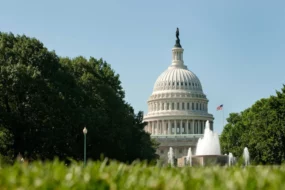The White House is reportedly planning to order the Department of Transportation to cut red tape around launch vehicle licensing—long a bogeyman for rocket-makers—but what will come of the process at the FAA isn’t clear.
What’s in the mix: Industry sources hold out hope that any modifications could be broader than the tinkering around the edges of the Part 450 launch and reentry regs discussed by the Biden administration.
Last week, ProPublica reported that the White House is considering a dramatic slate of potential changes that included:
- Using “all available authorities” to eliminate environmental reviews;
- Preempting state coastal commissions;
- Making the head of the FAA’s Office of Commercial Space Transportation (AST) a political appointee.
Hmm: It’s not obvious that secretary of Transportation (and acting NASA administrator) Sean Duffy can dispense with onerous environmental reviews at spaceports; that’s one reason why permitting reform has been top of mind for lawmakers looking to speed up projects from housing development, to energy infrastructure of all stripes. He may be able to speed them up by leveraging changes Trump has made in how the White House directs such reviews.
One tool for the job could be “categorical exclusions” to reviews under the National Environmental Policy Act (NEPA). These exceptions are typically used for routine activities that have no environmental impact, or that are regulated by other agencies. Using the exceptions for rocket launches might invite a legal challenge, but that’s not the sort of thing that holds up this administration.
Surfin’ Safari: Overruling state rules on coasts seems to be targeted at California officials, who have tried to block an increase in Falcon 9 launches at Vandenberg Space Force Base. While that decision is already the subject of several legal challenges, cutting out state regulators entirely would likely take an act of Congress.
Party Men: Some industry officials said making the government’s rocket regulator a political appointee would give the administration at least one influential figure who cares about space. Insiders, however, also despaired of finding someone who will take the job. And for all the friction with SpaceX, AST is known for being industry-friendly.
Part 450: Meanwhile, rocket company employees who handle compliance say environmental regulations aren’t usually the biggest factor delaying launches—or the real problem with the Part 450 rules, which were enacted by the Trump administration at the behest of space companies in 2020.
The big complaints surround the lack of clarity from the FAA on how to win approval for new launch vehicles without clear requirements.
“The flight safety analysis, it’s a math problem to meet a number listed in the regulations,” Tom Marotta, CEO of The Spaceport Company and a former commercial space official at the FAA, told Payload. “The system safety analysis is a qualitative assessment by experts on whether or not your system is safe enough.”
There are also long-running debates on when an application is considered officially filed. Trade groups say the FAA’s discretion around “starting the clock” lets the agency avoid statutory requirements to act quickly, while former regulators say it gives new rocket makers time to figure out their systems.
Two efforts are underway to change Part 450 regulations: An FAA committee was formed late last year to debate potential changes, while lawmakers asked for GAO to review the rules this year. The FAA didn’t respond to questions about changes to launch rules.
Fuel of the future: Many new launch vehicles are using methane for propellant, so regulators (and industry) are trying to understand the potential safety risks of methane in tank farms and vehicles. One silver lining from SpaceX Starship’s June pad explosion is new data for modeling exactly that kind of activity.
“There’s been a major, major challenge—especially in the federal ranges—of trying to understand the environmental impacts, as well as the safety impacts, of liquid methane, because it’s a propellant that hasn’t been used for a long time,” Marotta said.
Real talk: The US has seen more orbital launches each successive year since 2019, and I’ll bet you a dollar there will be more this year than last year. It could be hard for industry to make the case to the public that it needs more lenient rules—especially with all those pretty Starship debris showers.




